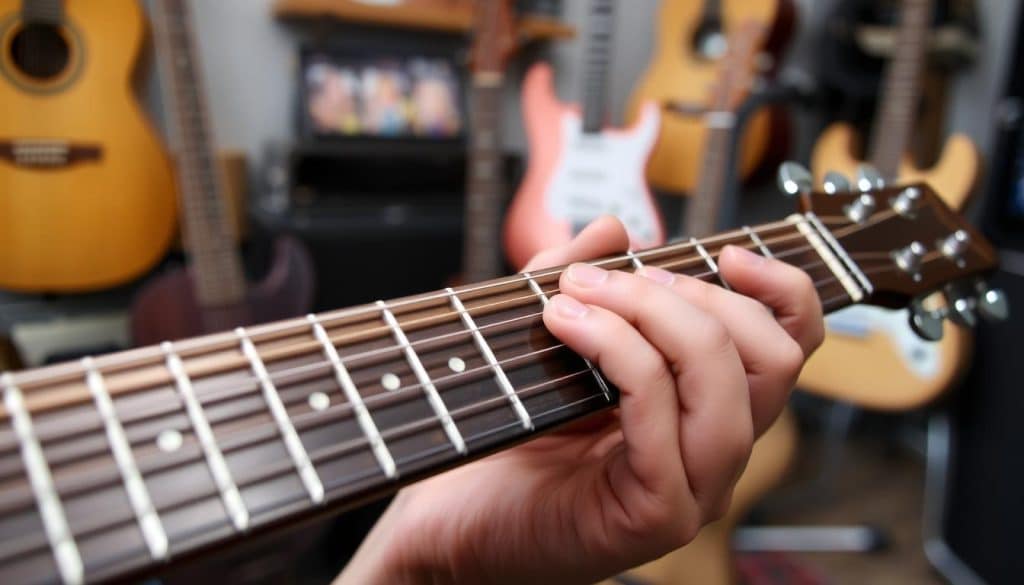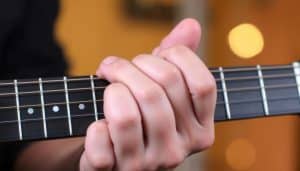Did you know the B chord is a tough one for new guitarists1? It’s a key chord for many songs in different music styles. This includes “American Woman” by The Guess Who and “Little Red Wagon” by Miranda Lambert. We’ve created a detailed guide to help you master the B Major chord easily.
By following our steps, you’ll learn to play the B chord smoothly. This skill is crucial for playing and switching between chords with confidence.
If you’re looking for an easy B chord guitar lesson or a thorough guitar B chord tutorial, this is the place. Learning the B chord will improve your guitar skills and expand your song choices.
Key Takeaways
- The B chord is considered one of the most challenging chords for beginner guitarists1.
- The B Major chord consists of the notes B, D♯, and F♯2.
- Mastering the B chord is essential for playing various genres like rock, pop, country, and classical1.
- You can play the B Major chord with the root note on the second fret of the fifth string2.
- Regular practice and persistence are key to mastering the B chord on the guitar1.
Introduction to the B Chord
The B chord is challenging but a must-know for guitarists. It shows up often in music. Its strong sound works well in many styles. So, learning it is important for improving your musical skills.
For newcomers, the B chord seems hard because it’s tough to play. It needs special finger placement, harder than simple chords3. Yet, with a good guide, you can learn it well and use it in songs you like.
The B chord uses a technique called barre, where you press all strings at one fret with one finger4. This makes a full, rich sound. Though it’s tough, especially next to open chords, learning it is worth it for more song choices and styles4.
There are easier versions, like B7 and Bm11, though they don’t sound as full3. If the full B chord is too hard, try the three-string version or Bsus4. These are good for kids or adults who struggle with the full chord3.
Here’s a comparison of various B chord forms to see how they differ and match:
| Chord Variation | Difficulty Level | Sound Quality | Ideal For |
|---|---|---|---|
| B Major | High | Full and Rich | Advanced Players |
| B7 | Moderate | Slightly Less Full | Intermediate Players |
| Bm11 | Low | Less Pleasing | Beginners |
| Bsus4 | Low | Distinct and Suitable for Acoustic | Beginners |
| 3-String B | Low | Less Full | Children and Struggling Adults |
In conclusion, you can master the B chord with practice and the right advice. Accept the challenge. Use a step-by-step guide for beginners, and focus on your finger placement. This will not just help you with the B chord, but improve your guitar skills overall.
Understanding the B Chord Notes
The B chord is crucial for guitarists, adding depth to music. It combines B, D♯, and F♯ to create a distinct harmony. It’s especially loved in rock and jazz music for its deep sound.
Breakdown of B Chord Notes: B, D♯, F♯
The B chord consists of B, D♯, and F♯ notes. These create a rich sound fitting for many songs56. You’ll need to use the barre chord technique to play it, pressing down several strings at once5. It can be played in different ways, using either the “E shape” or “A shape”.
Why These Notes Matter in Music
The B chord’s notes are very important in music. In B major, this chord feels like coming home6. Its flexible sound lets guitarists be creative with how they use B, D♯, and F♯. These notes also fit well in common chord progressions in various keys, like F major’s I – IV – V7.
Why the B Chord is Challenging for Beginners
The B chord is really tough for new guitar players. Its barre chord nature requires strong fingers and exact placement. Learning the ropes of guitar can be hard, especially mastering the B chord, which needs all strings to be pressed down unlike open chords where some strings are left open8.
For newbies, the B chord is tough to get because of the needed strength and lasting power, more so on an acoustic guitar. Compared to other chords, the B chord is a major hurdle in the learning path9. It’s found in many songs, like “American Woman” by The Guess Who, showing its crucial role despite being hard8.
A lot of beginners feel like giving up when they face the B chord, increasing dropout rates among new players9. However, there are easier versions of this chord that beginners can try to make learning smoother10.
The B chord has two main ways to play it—the 2nd position and the 7th position. The 2nd position is really tough because it needs a lot of finger strength8. Exercises to build hand strength can help beat these challenges, helping players get better at the B chord.
To see how hard it is, let’s look at this comparison:
| Chord | Difficulty Level | Mastery Success Rate |
|---|---|---|
| B Major (2nd position) | High | Low |
| E Minor | Low | High |
| A Major | Medium | Moderate |
Apps like Yousician give great advice and techniques for nailing tough chords, including the B chord, making them great helpers for wannabe guitarists10.
How to Position Your Fingers for the B Chord
Getting your fingers right is key to a clean B chord. Proper form helps your chord sound better. It also makes learning other chords easier.
Step-by-Step Finger Placement
Learning the B chord starts with your index finger. Put it across all strings at the second fret. Push down so every string sounds clear. Then, your middle finger should be on the G string’s third fret. Put your ring finger on the D string’s fourth fret, and your pinky on the A string’s fourth fret. Keep your fingers curved and use the tips for pressing. This prevents muting other strings115.
Common Missteps and How to Avoid Them
Making your B chord sound great means avoiding some errors. One big mistake is not pressing the barre finger hard enough. This can cause buzzing sounds. Make sure your index finger presses all strings evenly. It’s also important to keep your fingers curved properly. This helps you press the strings correctly with your fingertips11. Finally, check your hand’s position often. Ensure you’re not putting extra pressure and your thumb stays behind the guitar’s neck for support125.
Ways to Play the B Major Chord
The B major chord on the guitar is known for its tough barre shape. To play it well, you need to learn two main methods: the 2nd and the 7th positions.
2nd Position Method
The 2nd position is a popular way to play the B chord. You bar the second fret and use other fingers for the fourth fret of some strings. This gives the rich sound of barre chords10. Here’s how:
- Put your index finger across all strings at the second fret.
- Put your ring finger on the fourth fret of the D string.
- Your pinky goes on the fourth fret of the G string.
- Make sure your index finger presses down well to keep the notes clear.
Practice these steps to get the B chord sounding right.
7th Position Method
For a higher pitch, try the 7th position method. It has unique tones and involves barring the seventh fret with other fingers shaping the chord8. Here’s what to do:
- Bar the seventh fret with your index.
- Ring finger goes on the ninth fret of the A string.
- Pinky on the ninth fret of the D string.
- Press the eighth fret of the G string with your middle finger.
It might seem hard at first. But, practice makes switching between the 2nd and 7th positions easier. This way, you can play various B chord sounds.
How to play B chord on guitar
To play the B chord well, you need to master the right strumming ways. It’s all about the strength in your fingers and where to place them. The B major chord can be tough for new players. It needs you to use two barres at the same time and does not have an easy open string version1314. You will usually use your first and third fingers. Your first finger goes across the 2nd fret. And your third finger presses down across the 4th fret14
Playing B chord guitar tips suggest making sure each note sounds clear without any buzz. The B7 chord is a good choice for playing blues13. You can also try easier versions like the B “Power Chord”, which skips the 3rd note15. These simpler forms can be moved around the fretboard with no trouble15.
If you’re just starting, work on these easier B chords. This will help build your skills and add them to songs you play15. Good strumming methods lead to a sound that’s strong and fits well in your music. Keep your practice times short but do them often. This way, you’ll get a sound that’s clear and rings out nicely14.
Alternate Versions of the B Chord
Looking into different ways to play the B chord makes tackling its usual form easier. By learning varied forms, like the altered B chord techniques, your music gets more diverse. Here are some tips to get started.
Easy Modifications
One simple change is playing it with just three notes. Put your ring finger on the fourth fret of the G string and your pinky on the B string at the same fret510. This makes the chord easier and adds new sounds to your tunes.
Also, try versions that need pressing fewer strings. For example, use your first finger to press only the D, G, and B strings at the second fret810. These changes help you gain confidence and strengthen your fingers over time.
When to Use Alternate Versions
Use different B chord forms when full barre chords are tough or you want a new sound10. They’re great for moving between chords easier810. By including these forms and other tips for playing the B chord, your music will flow better and your creative side can shine.
| Variation | Ease of Playing | Sound Character |
|---|---|---|
| 3-note Version | High | Bright and Simplified |
| Barring D, G, and B Strings | Moderate | Balanced and Versatile |
| Full Barre Chord | Challenging | Full and Rich |
Using these altered B chord techniques lets you adjust your playing for different styles and abilities. Keep working at it, and your chord skills will grow stronger5.
Three-Note Versions of the B Chord
For guitar fans, starting with three-note B chord shapes is easy. These shapes make learning B chords simpler for new players. They help build a strong base for more complex chords.
Simplified Three-Note Variations
The three-note version is one of the simplest ways to play the B chord. By pressing down on the second fret across the A, D, and G strings, you get a great sound. This method is super for beginners because it’s easy and helps avoid sore hands16. It also makes moving to other chords smoother.
Benefits of Using Three-Note Versions
These three-note B chords are easy to remember and play. They’re great for getting better at more difficult chords and making your fingers stronger. You can play along with songs by The Beatles or Avril Lavigne16. Plus, they give you a clear sound that’s perfect before you tackle full barre chords.

To learn more about the B chord, including three-note versions, check out this complete guide on16.
Practicing the B Chord
Regular practice is key to mastering the B chord on the guitar. Through focused exercises, you’ll gain finger strength and agility. This will make a big difference in your B chord skills.
Exercises to Strengthen Your Chording Hand
To play the B chord well, you need a strong chording hand. Try these exercises for better performance:
- Finger Stretching: Stretch your fingers often to become more flexible. This makes playing the B chord easier.
- Barre Chord Training: Work on barre chords, like switching from F Major to B Major, which is hard, especially on an acoustic guitar8 and using the “F shape” at the seventh fret13.
- Partial B Chord Practice: Practice placing your fingers on the high E, B, and G strings for the partial B major shape13.
Simple Practice Routines
Structured practice routines speed up your learning. Plan your B chord guitar sessions like this:
- Warm-Up: Start with finger stretches and light exercises to get your hands ready.
- Chord Transitions: Work on moving between the E and B chords, and the A and B chords, as many lessons suggest813.
- B Chord Variations: Try easy B chord variations, like the moveable power chord, to understand the basics better15.
With these practice exercises and a daily routine, you’ll play the B chord smoothly. Stick with it, and you’ll see progress.
For more help, check out this detailed tutorial. It covers various techniques in depth.
Common Mistakes and How to Fix Them
When starting with the B chord, beginners often face a few common challenges. One major problem is muting strings by mistake. This usually happens because of not placing fingers properly or pressing too hard. Make sure your third finger presses the barre with just the last joint. Keep the rest of the finger angled up. This method helps avoid buzzes and ensures the sound is clear and full14.
Another usual mistake is incorrect fret placement, especially when using the third finger across the 2nd, 3rd, and 4th strings on the 4th fret. It’s important to place your fingers just right every time. This prevents unclear notes. Learning the B chord well also makes it easier to switch to other major chords because of its movable shape1415.
Applying too much pressure is also a common error. This often comes from thinking the chord is harder than it is. Too much pressure can cause pain or even small injuries. Focus on using just enough pressure on each string. Getting your fingers positioned right is key to fixing B chord mistakes15.
Often, beginners put off practicing tough chords like the B chord. They think they can wait until they really need it. But this strategy makes learning harder later on. Start working on these tricky chords early, even if it’s just a little bit at a time. Regular practice like this will help you produce clear, accurate notes without any buzz15.
To avoid and fix these common mistakes, follow these tips for learning the B chord. Keep practicing consistently. Remember, becoming proficient takes patience, exactness, and steady practice.
Transitioning Between B Chord and Other Chords
Switching between the B chord and other chords makes your guitar playing smoother and more dynamic. To master these switches, you need to understand B chord transition techniques and how to switch chords smoothly.
From E to B Chord
Moving from E to B may seem hard at first, but practicing makes it easier. First, find a finger that can guide you smoothly between chords on the fretboard. For instance, your index finger can guide you when moving from E to B because it stays close to the same fret for the bar chord shape17.
Using a metronome in your practice helps a lot. Start by strumming down once at the start of each bar. As you get better, increase the speed by 5 bpm until you can do it smoothly18.
From A to B Chord
Switching from A to B is a shift that benefits from knowing chord switching techniques. Visualization exercises help you remember where your fingers go, making it easier to switch without looking18. Start with one finger, like your ring finger on the B string, to anchor the change. Then add the other fingers to complete the transition18.
Breaking chord progressions into smaller parts also makes mastering these transitions easier18.
Use these tips to move between the B chord and others easily. This will make your guitar skills sharper.
Pro Tips for Mastering the B Chord
Learning the B chord on the guitar is a journey that needs patience and practice. You’ll find expert advice here focused on practice techniques and using them in real life. This will help you beat this tough chord in a smart way.
Practice Techniques for Quick Mastery
To master the B chord quickly, practice consistently and focus. Think of it as getting ready for a marathon; split your practice into smaller steps. First, get the chord shape down, then mix in melody and work on moving your index finger. This approach builds muscle memory and dexterity over time19.
Practice using the 2nd and 7th positions, as these are key for playing the B chord8. Doing these exercises for about five minutes a day helps you improve steadily19.
Real-World Application in Songs
Using the B chord in songs is a great way to enhance your skills. Try playing tunes like “American Woman” by The Guess Who, “Little Red Wagon” by Miranda Lambert, and “Dream Police” by Cheap Trick8. This can help you remember how to form the chord and get better at changing chords. Also, there are easier versions of the B chord that don’t need a bar. These are better for beginners to play along with these tracks10.
Start with easier chords such as E, C, or G to make your fingers stronger. Then, moving on to the B chord will be less difficult8.






